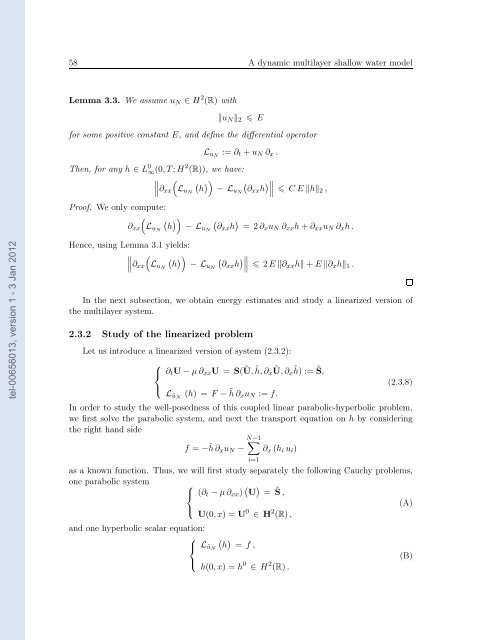Modélisation, analyse mathématique et simulations numériques de ...
Modélisation, analyse mathématique et simulations numériques de ...
Modélisation, analyse mathématique et simulations numériques de ...
You also want an ePaper? Increase the reach of your titles
YUMPU automatically turns print PDFs into web optimized ePapers that Google loves.
tel-00656013, version 1 - 3 Jan 2012<br />
58 A dynamic multilayer shallow water mo<strong>de</strong>l<br />
Lemma 3.3. We assume uN ∈ H 2 (R) with<br />
uN2 E<br />
for some positive constant E, and <strong>de</strong>fine the differential operator<br />
LuN := ∂t +uN ∂x.<br />
Then, for any h ∈ L 0 ∞ (0,T;H2 (R)), we have:<br />
<br />
<br />
∂xx h <br />
∂xxh CEh2,<br />
Proof. We only compute:<br />
<br />
h <br />
∂xx<br />
LuN<br />
LuN<br />
Hence, using Lemma 3.1 yields:<br />
<br />
<br />
∂xx h <br />
LuN<br />
− LuN<br />
− LuN<br />
− LuN<br />
∂xxh = 2∂xuN ∂xxh+∂xxuN ∂xh.<br />
∂xxh 2E∂xxh+E∂xh1.<br />
In the next subsection, we obtain energy estimates and study a linearized version of<br />
the multilayer system.<br />
2.3.2 Study of the linearized problem<br />
L<strong>et</strong> us introduce a linearized version of system (2.3.2):<br />
⎧<br />
⎨<br />
⎩<br />
∂tU−µ∂xxU = S( Ũ,˜ h,∂x Ũ,∂x ˜ h) := ˜ S,<br />
LũN (h) = F −˜ h∂xuN := f.<br />
(2.3.8)<br />
In or<strong>de</strong>r to study the well-posedness of this coupled linear parabolic-hyperbolic problem,<br />
we first solve the parabolic system, and next the transport equation on h by consi<strong>de</strong>ring<br />
the right hand si<strong>de</strong><br />
f = −˜ N−1 <br />
h∂xuN − ∂x(hiui)<br />
as a known function. Thus, we will first study separately the following Cauchy problems,<br />
one parabolic system ⎧<br />
⎨ (∂t −µ∂xx)<br />
⎩<br />
U = ˜ S,<br />
(A)<br />
and one hyperbolic scalar equation:<br />
⎧<br />
⎨<br />
⎩<br />
i=1<br />
U(0,x) = U 0 ∈ H 2 (R),<br />
LũN<br />
h = f ,<br />
h(0,x) = h 0 ∈ H 2 (R).<br />
(B)

















